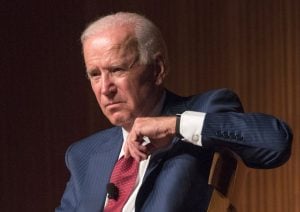The government has been shut down for a month, and now the Los Angeles Unified School District (LAUSD) has been on strike for a week. The district and unions reached an impasse last Friday, and the teachers left the schools on Monday. In interviews, the head of the local teachers union has echoed three complaints: loss of students to charter schools, too little pay, and too big of classes.
On the district side, the superintendent wants to meet demands, but seeing as LAUSD is projected to run a deficit of $600 million in the 2019-2020 school year, all possibilities for budgeting in the union’s requests are null. While the news so far has focused on the supposed plight of underpaid teachers, as a teacher myself, I can say that strikes and teacher salaries are far more complex than many realize.
Here are three basic facts that complicate each of the union’s demands:
1. Charter schools aren’t to blame—pensions are
Between 2009 and 2015, LAUSD lost roughly 100,000 students and the funding that comes with them. The unions blame charter schools, which to some extent is a valid claim; they account for roughly 50 percent of the total loss. Considering a decrease of almost one-sixth of their students, one would assume there was a similar reduction of staff throughout LAUSD. The contrary happened, and as the district shrank, expenditures for staffing increased. The financial report attributes the blame to various factors. An abundance of waste in every department is the biggest culprit, but there are two others that stand out.
Discussions of funding miss a larger issue. What about the schools has made so many parents choose charter or traditional public schools?
The first area of financial stress comes from special education services. After the passage of the IDEA Act in 1990, which mandated special-ed support in all public schools, the federal government promised to pay 40 percent of the rise in costs that would accompany an increase in support staff. Since its passage, the federal government has reached only a quarter of its projected commitment. The second large issue is pensions. The graph below shows the ever-increasing commitments of California’s two teacher pensions funds, which have skyrocketed in the past few years, draining the district’s reserves and any discretionary spending ability.
Source: LAUSD

That said, discussions of funding miss a larger issue. What about the schools has made so many parents choose charter or traditional public schools? Instead of lambasting charter schools, the loss of students should act as an incentive for public schools to modify their instruction, study the systems that are presumably more effective at these charter schools, and match the success that their competitors have had. Rather than place blame, they should improve their educational product and fight for customers.
To begin with, California ranks fifth in the nation for teacher pay, doling out on average $74,940. On top of that, LAUSD teachers make more than the average Californian teacher, with 56 percent of them earning over $76,000.
Furthermore, studies overwhelmingly show that an expansion of school choice in districts leads to saved money. Contrary to the union’s complaints, an expansion of charters and vouchers are more likely to save money than drain the public schools.
2. Teachers are already compensated well
Compared to doctors or executives, a teacher’s paycheck appears small. Yet I showed my medical insurance to a doctor once and found it was better and cheaper than a man who worked in the health care field itself. Paychecks tell only a small part of the story.
To begin with, California ranks fifth in the nation for teacher pay, doling out on average $74,940. On top of that, LAUSD teachers make more than the average Californian teacher, with 56 percent of them earning over $76,000. Considering that accounts for nine months of work, that paycheck works out to be about on average with architects. All of that still doesn’t account for their benefits. Among all public employees, teachers bring in the highest retirement benefits, averaging $6.22 per hour worked. Assuming they work 40 hours a week for 40 weeks a year, that is just shy of an additional $10,000.
Again, contrary to the union’s claims, these numbers miss a larger issue. An early educator can outperform their colleagues and make no extra money, while a veteran teacher with little or no interest in improving their craft can bring home an architect’s salary. Perhaps merit-based pay would be a better demand for them to make. This approach not only fixes an unfair compensation structure but also shows a moderate benefit to student learning.
3. Class size is a serious financial issue
Studies on class size almost unanimously show a positive correlation at the elementary level; fewer students means better learning. The effect weakens, though, as the age increases. At the high school level, positive trends don’t start to appear until the class difference reaches seven or more students. Considering the Brookings Institute estimates that “increasing the pupil/teacher ratio in the U.S. by one student would save at least $12 billion per year in teacher salary costs alone,” districts need to weigh the cost-benefit analysis of decreasing class sizes. In the case of LAUSD, where the district proposed a class size cap of 39 at the high school level, all agree that smaller classes are ideal. Unfortunately, in the face of their current deficit, the district should look to other strategies for improving student success.
The fiscal review of the schools warned that “a combination of difficult, substantial and immediate decisions will be required. Failure to do so could lead to the insolvency of the LAUSD, and the loss of local governance authority that comes from state takeover.”
This strike accomplishes two things: an interruption of student learning and the potential for even more financial stress.
If the strikers have one thing correct, it is that the stakes are high in this debate. However, the union’s current demands are often the cause of—rather than the solution to—the district’s precarious situation and are simply not financially soluble.
I’m a teacher in Wisconsin and am watching this strike from half a country away. My final personal reflection is this: My commitment is foremost to my students. Were my district to ever strike, I would continue to go to work and, if barred from the building, would send optional email assignments to my students. With that in mind, this strike accomplishes two things: an interruption of student learning and the potential for even more financial stress.




